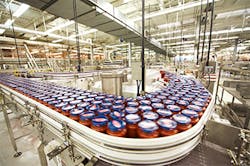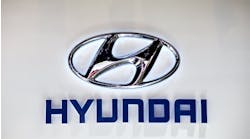Building on Legacy: Rochester Secures its Future with Advanced Manufacturing
Dave Stoklosa embodies the spirit of Rochester, New York. He knows how to move from a challenging situation to a profitable one. While working for Kodak he was in charge of the Eastman Business Park located in Rochester. With the recession in 2008, Kodak found the burden of supporting this massive park, which includes its own waste water treatment center and even a fire department, difficult so it began selling off some property.
One buyer was LiDestri Food and Beverage. The company, which produces more than two million jars of sauces, dips and beverages daily, bought a building in 2009. Since then the company has purchased a number of properties in the park and now has 1.5 million square feet which houses manufacturing facilities as well as an Innovation Center. Product offering have expanded to include specialty- and boutique-style brands, plus a line of high-proof spirits.
“For a food manufacturer, the space was a good fit,” explains Stoklosa. “Energy, a substantial cost factor in food manufacturing, is much less in the park as compared to a municipal source,” said Stoklosa who joined LiDestri in 2010 as director of business development and currently serves as vice president.
Another advantage the company enjoys is the support of New York State which has tied a large part of its economic development strategy to industrial development at Eastman Business Park. The 1,200 acre campus encompasses more than 100 buildings, 2.5 million square feet of space, and over 50 miles of integrated roads and more than 60 companies. (Manufacturing companies include specialty chemicals, thin films and medical products.)
The State provides funds to spur growth to companies in the park. Last year LiDestri received a grant of $468,300 for a high-pressure processing system whose technology provides food retailers a method of preserving the quality of fresh foods while eliminating any potentially harmful pathogens present in the food.
While advanced technology is important to growth, perhaps the more important advantage to LiDestri, and other manufacturers in Rochester, is the legacy talent of its workforce. Due to the skills that developed around Kodak, which at one time employed 60,000, Stoklosa says that he, unlike many manufacturing companies, doesn’t have a problem finding technical, engineering and managerial skill. Although finding first line operators is still a challenge.
And the future pipeline talent is also secure as Rochester's highly educated workforce derives from 19 colleges and universities with approximately 87,500 enrolled students that award more than 19,000 associate's, bachelor's, and graduate or professional degree diplomas each year. Universities include Cornell, Rochester Institute of Technology and many others.
With a plentiful workforce, LiDestri felt confident to partner with G’s Fresh Ltd. of the UK, to form Love Beets USA. The new company is based at LiDestri’s facility and will process and package beet products for the U.S. market. The economic support and assistance from local and state agencies was a critical factor in locating the Love Beets processing plant in Rochester. New York State, through Empire State Development, provided a $1 million capital grant, up to $1.5 million in Excelsior tax credits and a low interest loan.
“This joint venture represents a very unique and holistic opportunity to develop a vertically integrated supply chain in Western N.Y., and to bring significant agricultural benefits to the region,” said LiDestri CEO Giovanni LiDestri. “Once established, the relationships to local farmers, access to organic fields and beets, and the subsequent centralized processing of the crop, will not be easily duplicated elsewhere.”
Expanding the food supply chain will further strengthen the more than 100 food and beverage manufacturing companies in the Rochester region which include; Kraft Foods, Barilla American, Mott’s, Muller Quaker Dairy and Seneca Foods.
Battery and Energy Storage Sector
While food manufacturing is a growing part of the Eastman Business Park, another emerging area is the battery and energy storage sector. In 2010, the New York Battery and Energy Storage Technology Consortium (NY-BEST) was created to position this region as a leader in this sector which includes applications in transportation, grid storage and power electronics.
“Back in 2010 we realized that battery energy storage was going to transform two important industrial sectors, transportation and the electricity grid,” explained Dr. William Acker, executive director of NY-BEST.
The State of New York saw the potential as well so using funds received from coal power plant settlements , combined with public and private funds NY-BEST was created. Over 30 companies including GE, BAE Systems, Raymond Corp. and many others were involved at the beginning and the group has grown to 150 members. Members include manufacturers, academic institutions, utilities, technology and materials developers, start-ups, government entities, engineering firms, systems integrators and end-users.
Rochester was chosen as a location for this industry as it had a lot of key assets and core competencies that made it attractive said Akers. The region has the University of Rochester's Energy Research Initiative, a leading institute on energy storage. “There are also companies performing pioneering work in the field that have spawned star- ups and collaborations in the region,” Akers said. The region's core manufacturing assets are robust with more than 1,500 manufacturers in the Greater Rochester area employing nearly 66,000 people. The base is primarily in high tech precision sectors, with its largest employment sectors being machinery (12,495), computer & electronic products (9,392), and transportation equipment (1,827). These skills translate well to the battery energy and storage sector.
The first big win for the consortium was when in October of 2013 NOHMs, (Nanoscale Organic Hybrid Materials), which was started out of Cornell University, located its pilot nanoscale battery materials manufacturing facility at Eastman Business Park. Research, development and an advanced manufacturing facility for lithium sulfur battery materials and battery cell prototypes were created.
NOHMs is developing lightweight electrode and electrolyte materials that have the potential to supply more than twice the energy at half the cost of lithium-ion batteries that are currently used in consumer, commercial, and military devices. NOHMs is partnering with battery and product OEMs and five federal agencies to commercialize these materials for use in military radios, mobile military base energy storage, implantable medical devices, air and spacecraft, mobile phones, and electric vehicles. The company estimates that its materials products address a $14 billion market opportunity.
NOHMs has also joined with NY-BEST and its BEST Test and Commercialization Center, which will provide access to testing and prototyping equipment to help energy storage manufacturers such as NOHMs accelerate the development and commercialization of new technologies and products.
Last October saw further development as the New York State Energy Research and Development Authority (NYSERDA) partnered with nine companies taking part in innovative energy storage research and development projects that will bring increased energy efficiency and reliability to alternative-fuel vehicles and the electric grid. Under this program, companies will work on "bench-to-prototype" technologies in an effort to move clean-technology energy storage devices from the lab to the marketplace. "Technologies include advanced batteries, ultracapacitors, fuel cells and control modules. Energy storage devices such as ultracapacitors, for example, serve a vital role in providing instant energy for hybrid and electric vehicles, as well as electronic devices.
The State’s continuing financial support for this sector as well as the development of advanced manufacturing in the Eastman Business Park reflects the commitment of the state to ensure that NYSERTA is successful. One division of the NYSERTA is the NY Green Bank. The bank works in partnership with the private sector to increase investments into New York’s clean energy markets, creating a more efficient, reliable and sustainable energy system.
“This financial tool is a great asset for the area in that it can offer funds to provide capital,” explains Mark S. Peterson, president and CEO of Greater Rochester Enterprise. “Combining financial assistance with the many advantages of Eastman Business Park offers companies a plug and play scenario.”
The long history of manufacturing based out of the Eastman Business Park gives Rochester a great advantage says Peterson. “The many amenities of the park including a comprehensive suite of test, validation, prototyping, and pilot manufacturing tools are specifically designed to help accelerate innovation out of the lab to high volume manufacturing in the energy storage sector."
Legacy Workforce
Peterson points out that the region is focused on more than just filling the financial gaps, it is also working to fill any educational gaps.
“We have been very active in mining data and surveying local employers to discover the specific skills needed,” explains Dr. Anne Kress, president of Monroe Community College. When Kress discovered that a program which lasted a year was too long for both employers to wait for workers and certain workers to be without jobs, she cut the class to six months. The graduation rate for this class went up to 80% from 34%.
“We have reached out to non-traditional sources of employees ranging from those who have skills but haven’t found a job to those who are in poverty and haven’t had access to training,” says Kress.
And on the employer side the college works with smaller companies who don’t always have resources to find training programs some of which come with tuition reimbursement.
“One of the real benefits we have found is that having strong industry partners and advisory councils we are on top of the needs that area businesses have and make sure that we are providing students with the training they need to get into these strong advanced manufacturing careers,” Kress explained.
And once students find jobs with these companies, they tend to stay. In fact retaining employees isn’t a major problem in this area according to Stoklosa. “Rochester is a nice place to live where many people put down roots and raise a family. It’s a little known secret in Upstate New York.”





